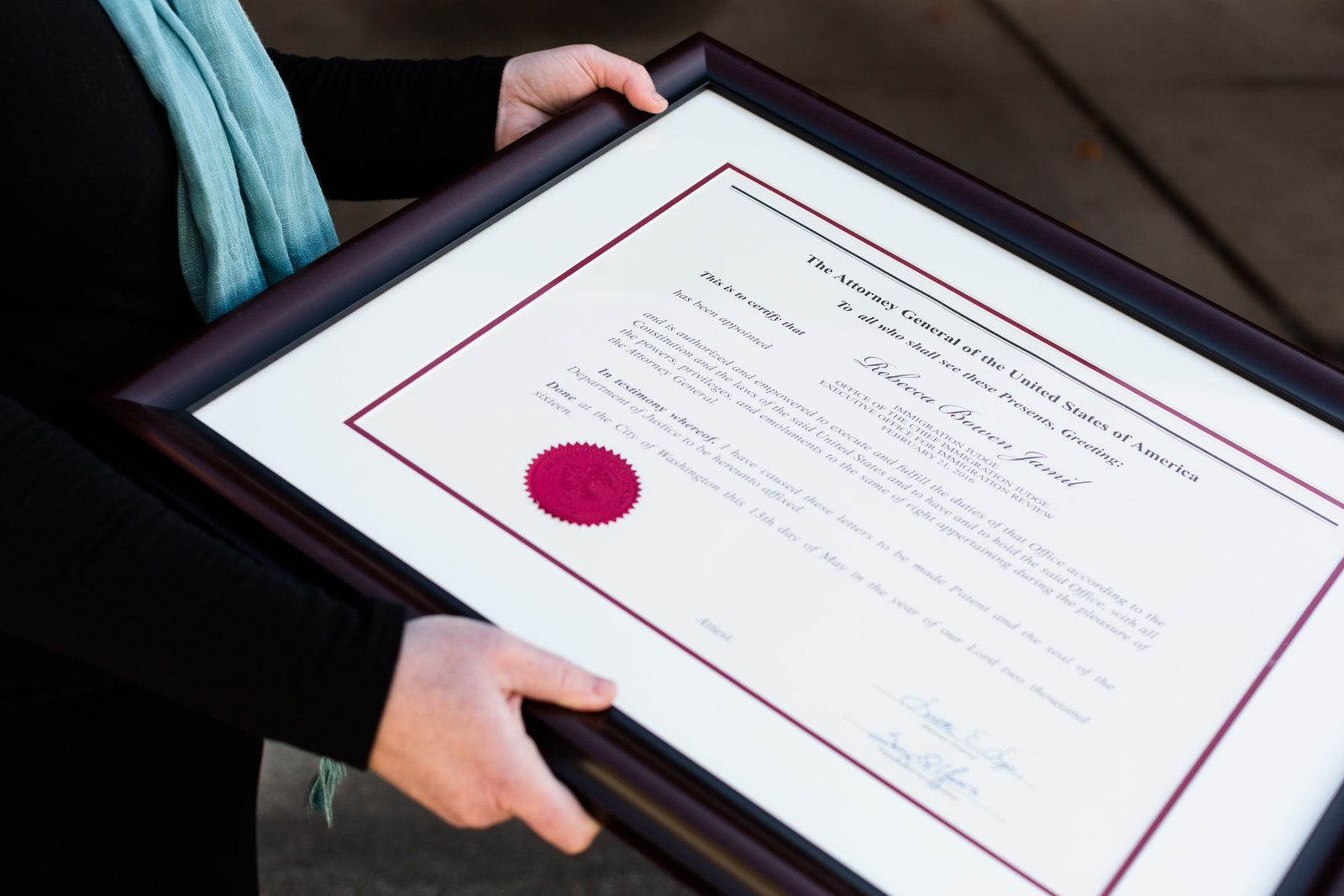https://www.jeffreyschase.com/blog/2019/4/21/a-better-approach-to-unable-or-unwilling-analysis
A Better Approach to “Unable or Unwilling” Analysis?
“K.H., a Guatemalan native and citizen, was kidnapped, beaten, and raped in Guatemala when she was seven years old.” That horrifying sentence begins a recent decision of the U.S. Court of Appeals for the Sixth Circuit denying asylum to that very same youth.
In that case, DHS actually stipulated that the applicant was persecuted on account of a statutorily protected ground. But the insurmountable hurdle for K.H. was her need to establish that the government of Guatemala was unable or unwilling to control the gang members who had persecuted her.
Asylum is supposed to afford protection to those who are fleeing something horrible in their native country. Somehow, our government has turned the process into an increasingly complex series of hoops for the victim to jump through in order to merit relief. Not long after Congress enacted legislation in 2005 making it more difficult for asylum seekers to be found believable, the Seventh Circuit Court of Appeals acknowledged that “asylum hearings are human events, and individuals make mistakes about immaterial points…Basing an adverse credibility finding on these kinds of mistakes appears to be more of a game of ‘gotcha’ than an effort to critically evaluate the applicant’s claims.” Sankoh v. Mukasey, 539 F.3d 456, 470 (7th Cir. 2008). More recent developments have extended the game of “gotcha” beyond credibility determinations and into substantive questions of law.
It is recognized that one can qualify for asylum where the persecutors are not part of the government, provided that the government is either unable or unwilling to control them. In a recent amicus brief, the Office of the United Nations High Commissioner for Refugees (UNHCR) correctly stated what seems obvious: that “the hallmark of state protection is the state’s ability to provide effective protection, which requires effective control of non-state actors.” As the whole point of asylum is to provide humanitarian protection to victims of persecution, of course the test must be the effectiveness of the protection. UNHCR continued that the fact that a government has enacted laws affording protection is not enough, as “even though a particular State may have prohibited a persecutory practice…the State may nevertheless continue to condone or tolerate the practice, or may not be able to stop the practice effectively.”
When I was an immigration judge, I heard testimony from country experts that governments were often inclined to pass laws or even create government agencies dedicated to the protection of, e.g. religious minorities solely for cosmetic reasons, to give the appearance to the international community that it was complying with international human rights obligations, when in reality, such laws and offices provided no real protection. But UNHCR recognizes that even where there is good intent, “there may be an incongruity between avowed commitments and reality on the ground. Effective protection depends on both de jure and de facto capability by the authorities.”
Yet U.S. law has somehow recently veered off course. In unpublished decisions, the BIA began applying what seems like a “good faith effort” test, concluding that the asylum applicants had not met their burden of establishing that the government was “unable or unwilling to protect” if there was evidence that the government showed some interest in the issue and took some action (whether entirely effective or not) to provide protection. Such approach wrongly ignored whether the government’s efforts actually resulted in protecting the asylum seeker. Next, former Attorney General Jeff Sessions weighed in on the topic in his decision in Matter of A-B-, in which he equated a government’s unwillingness to control the persecutors (which could potentially be due to a variety of factors, including fear, corruption, or cost) with the much narrower requirement that it “condone” the group’s actions. He further opined that an inability to control requires a showing of “complete helplessness” on the part of the government in question to provide protection. These changes have resulted in the denial of asylum to individuals who remain at risk of persecution in their country of origin.
In K.H., it should be noted that the evidence that convinced the BIA of the Guatemalan government’s ability to afford protection included a criminal court judge’s order that the victim be moved to another city, be scheduled for regular government check-ins as to her continued safety there (which the record failed to show actually occurred), and the judge’s further recommendation that the victim seek a visa to join her family in the U.S. A criminal court judge’s directive to move to another city and then leave for a safer country hardly seems like evidence of the Guatamalan government’s ability or willingness to provide adequate protection; quite the opposite. But that is how the BIA chose to interpret it, and somehow, the circuit court found reason to let it stand under its limited substantial evidence standard for review.
Challenges to these new interpretations are reaching the circuit courts. Addressing the issue for the first time, the Sixth Circuit in K.H. created a rather involved test. The court first set out two broad categories, consisting of (1) evidence of the government’s response to the asylum seeker’s persecution, and (2) general evidence of country conditions. WIthin broad category (1), the court created three subcategories for inquiry, namely: (1) whether the police investigated, prosecuted, and punished the persecutors after the fact; (2) the degree of protection offered to the asylum seeker, again after the fact of their being persecuted, and (3) any concession on the part of the government, citing a Third Circuit decision finding a government’s relocation of a victim to Mexico as an admission by that government of its own inability to provide adequate protection. (Somehow, the criminal judge’s order to relocate K.H. to another city and then seek a visa to the U.S. was not viewed as a similar concession by the BIA.)
Under broad category (2) (i.e. country conditions), the court established two subcategories for inquiry, consisting of (1) how certain crimes are prosecuted and punished, and (2) the efficacy of the government’s efforts.
Some shortcomings of this approach jump out. First, many asylum applicants have not suffered past persecution; their claims are based on a future fear of harm. As the Sixth Circuit approach is based entirely on how the government in question responded to past persecution, how would it apply to cases involving only a fear of future persecution?
Secondly, and more significantly, the Sixth Circuit’s entire approach is to measure how well a government acted to close a barn door after the horse had already escaped. The test is the equivalent of measuring the owner of a china shop’s ability to protect its wares from breakage by studying how quickly and efficiently it cleaned up the broken shards and restocked the shelves after the fact.
I would like to propose a much simpler, clearer test that would establish with 100 percent accuracy a government’s inability or unwillingness to provide effective protection from a non-state persecutor. The standard is: when a seven year old girl is kidnapped, raped, and beaten, the government was presumably unable to provide the necessary effective protection.
If this seems overly simplistic, I point to a doctrine commonly employed in tort law, known as res ipsa loquitur, which translates from the Latin as “the thing speaks for itself.” It is something all lawyers learn in their first year of law school. I will use the definition of the concept as found on the Cornell Law School website (which is nice, as I recently spoke there), which reads:
In tort law, a principle that allows plaintiffs to meet their burden of proof with what is, in effect, circumstantial evidence. The plaintiff can create a rebuttable presumption of negligence by the defendant by proving that the harm would not ordinarily have occurred without negligence, that the object that caused the harm was under the defendant’s control, and that there are no other plausible explanations.
The principle has been applied by courts since the 1860s.
So where the government has stipulated that the respondent suffered persecution on account of a protected ground, should we really then be placing the additional burden on the victim of having to satisfy the “unable or unwilling” test through the above line of inquiry set out by the Sixth Circuit? Or would it be more efficient, more, humane, and likely to reach a more accurate result that conforms to the international law standards explained by UNHCR, to create a rebuttable presumption of asylum eligibility by allowing the asylum applicant to establish that the persecution would not ordinarily have occurred if the government had been able and willing to provide the protection necessary to have prevented it from happening? The bar would be rather low, as seven year olds should not be kidnapped, raped, and beaten if the police whose duty it was to protect the victim were both able and willing to control the gang members who carried out the heinous acts. The standard would also require a showing that such harm occurred in territory under the government’s jurisdiction (as opposed to territory in which, for example, an armed group constituted a de facto government).
Upon such showing, the burden would shift to DHS to prove that the government had the effective ability and will to prevent the persecution from happening in the first place (as opposed to prosecuting those responsible afterwards) by satisfying whatever complex, multi-level inquiry the courts want to lay out for them. However, DHS would not meet its burden through showing evidence of the government’s response after the fact. Rather, it would be required to establish that the Guatemalan government provides sufficient protection to its citizens to prevent such harm from occurring in the first instance, and that what happened to the asylum applicant was a true aberration.
Shifting the burden to DHS would make sense. It is often expensive to procure a respected country expert to testify at a removal proceeding. As more asylum applicants are being detained in remote facilities with limited access to counsel, it may be beyond their means to retain such experts themselves. The UNHCR Handbook at para. 196 recognizes the problems asylum seekers often have in documenting their claims. It thus concludes that “while the burden of proof in principle rests on the applicant, the duty to ascertain and evaluate all the relevant facts is shared between the applicant and the examiner. Indeed, in some cases, it may be for the examiner to use all the means at his disposal to produce the necessary evidence in support of the application.”
Furthermore, ICE attorneys who should welcome the role of such experts in creating a better record and increasing the likelihood of a just result have taken to disparaging even highly respected country experts, sometimes subjecting them to rather hostile questioning that slows down proceedings and might discourage the participation of such experts in future proceedings. Therefore, letting ICE present its own experts might prove much more efficient for all.
Incidentally, UNHCR Guidelines published last year state that while the Guatemalan government has made efforts to combat gang violence and has demonstrated some success, “in certain parts of the country the Government has lost effective control to gangs and other organized criminal groups and is unable to provide protection…” The report continued that some temporary police operations have simply caused the gangs to move their operations to nearby areas. The report further cited the problem of impunity for violence against women and girls, as well as other groups, including “human rights defenders, legal and judicial professionals, indigenous populations, children and adolescents, individuals of diverse sexual orientations and/or gender identities, journalists and other media workers.” The same report at pp. 35-36 also references corruption within the Guatemalan government (including its police force) as a “widespread and structural problem.” DHS would have to present evidence sufficient to overcome such information in order to rebut the presumption triggered by the fact of the persecution itself.
Another benefit of the proposed approach would be its impact on a victim’s eligibility for a grant of humanitarian asylum, which may be granted based on the severity of the past persecution suffered even where no fear of future persecution remains. A child who was kidnapped, raped, and beaten by gang members at the age of seven, and who will certainly suffer psychological harm for the rest of her life as a result, should clearly not be returned against her will to the country in which she suffered such horrific persecution. Yet the Sixth Circuit upheld the BIA’s denial of such humanitarian protection, because in affirming the Board’s conclusion that K.H. had not met her burden of showing the Guatemalan government was unable and unwilling to protect her (based solely on its after-the-fact response), it also upheld the BIA’s finding that K.H. did not meet all of the requirements necessary for her to have established that she suffered past persecution. This in spite of the fact that DHS stipulated that she did suffer past persecution on account of a statutorily protected ground. As only an applicant who established past persecution is eligible for humanitarian asylum, this very convoluted approach successfully blocked such remedy.
However, if the standard were to assume that the harm suffered by the asylum applicant triggers the presumption that the Guatemalan government was unable or unwilling to prevent it, the evidence that government’s subsequent efforts to prosecute those responsible and protect the victim would not serve to rebut the presumption. Rather, it would be considered as possible evidence of changed conditions in the country of origin sufficient to show that after suffering past persecution, the asylum applicant would now have no further fear of returning there. This critical distinction would then allow K.H. to be granted humanitarian asylum even if the government prevailed in its arguments, as opposed to facing deportation that would return her to the scene of such extreme persecution.
Copyright 2019 Jeffrey S. Chase. All rights reserved.
The Immigration Court: Issues and Solutions
“a mere stranger” and then see how your “head in the sand” legal analysis works out.

















